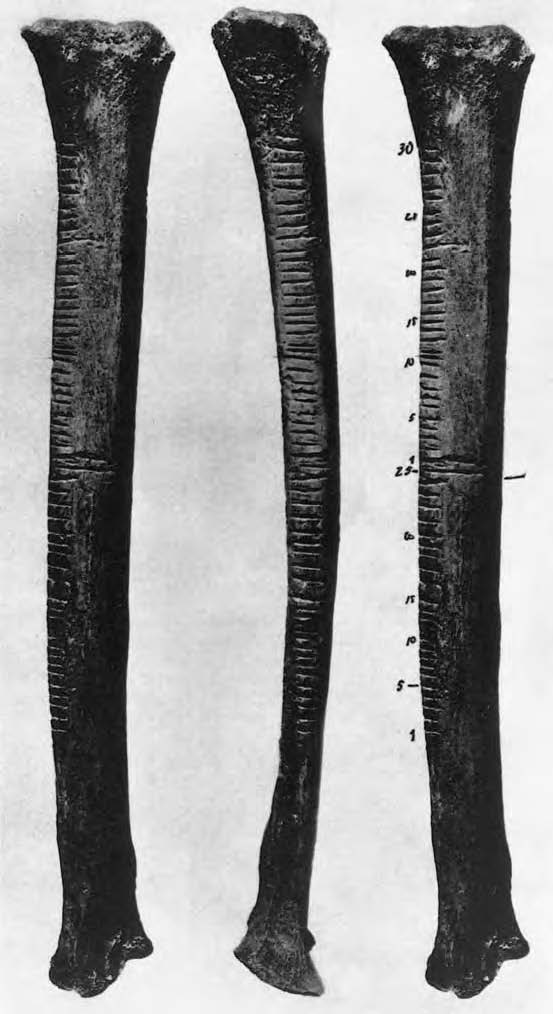The Idea of Number and Counting
"The first motivation for people to create number was the human desire to the manyness of a set of objects. In other words, to know how many duck’s eggs are to be divided amongst family members or even how many days until the tribe reaches the next watering hole, how many days wills it be until the days grow longer and the nights shorter, how many arrow heads do one trade for canoe? Knowing how to determine the manyness of a collection of objects must surely have been a great aid in all areas of human endeavour.
"The earliest direct evidence of counting is two animal bones which show clear group marks. One is a 35,000 year old baboon’s thigh bone from the Lebembo Mountains of Africa and other is a 33,000 year old wolf bone from Czechoslovakia. The wolf bone found at ancient human campsite is especially intriguing. It was notched with fifty five marks, grouped in eleven set of five marks each." (Dutta, 2011)

"The use of tally marks to record counts was prominent among the prehistoric peoples of the Near East. Archaeological excavations have unearthed a large number of small clay objects that had been hardened by fire to make them more durable. These handmade artifacts occur in a variety of geometric shapes, the most common being circular disks, triangles, and cones. The oldest, dating to about 8000 b.c., are incised with sets of parallel lines on a plain surface; occasionally, there will be a cluster of circular impressions as if punched into the clay by the blunt end of a bone or stylus. Because they go back to the time when people first adopted a settled agricultural life, it is believed that the objects are primitive reckoning devices; hence, they have become known as “counters” or “tokens.” It is quite likely also that the shapes represent different commodities. For instance, a token of a particular type might be used to indicate the number of animals in a herd, while one of another kind could count measures of grain. Over several millennia, tokens became increasingly complex, with diverse markings and new shapes. Eventually, there came to be 16 main forms of tokens. Many were perforated with small holes, allowing them to be strung together for safekeeping. The token system of recording information went out of favor around 3000 b.c., with the rapid adoption of writing on clay tablets." (Burton, 1985, p. 3)
Permutations and Combinations
"The concepts of permutations and combinations can be traced back to the advent of Jainism in India and perhaps even earlier. The credit, however, goes to the Jains who treated its subject matter as a self-contained topic in mathematics, under the name Vikalpa.
"Among the Jains, Mahavira, (around 850 A.D.) is perhaps the world’s first mathematician credited with providing the general formulae for permutations and combinations.
In the 6th century B.C., Sushruta, in his medicinal work, Sushruta Samhita, asserts that 63 combinations can be made out of 6 different tastes, taken one at a time, two at a time, etc. Pingala, a Sanskrit scholar around third century B.C., gives the method of determining the number of combinations of a given number of letters, taken one at a time, two at a time, etc. in his work Chhanda Sutra. Bhaskaracharya (born 1114 A.D.) treated the subject matter of permutations and combinations under the name Anka Pasha in his famous work Lilavati. In addition to the general formulae for \( nCr \) and \( nPr \) already provided by Mahavira, Bhaskaracharya gives several important theorems and results concerning the subject.
Outside India, the subject matter of permutations and combinations had its humble beginnings in China in the famous book I–King (Book of changes). It is difficult to give the approximate time of this work, since in 213 B.C., the emperor had ordered all books and manuscripts in the country to be burnt which fortunately was not completely carried out. Greeks and later Latin writers also did some scattered work on the theory of permutations and combinations.
The first book which gives a complete treatment of the subject matter of permutations and combinations is Ars Conjectandi written by a Swiss, Jacob Bernoulli (1654 – 1705), posthumously published in 1713. This book contains essentially the theory of permutations and combinations as is known today." (Lal, 2002, p. 158-159)